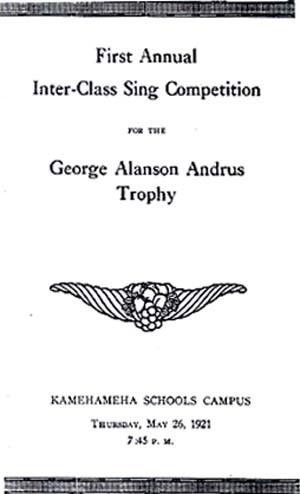Format Singing competition Venue Neal Blaisdell Center | Host Kamehameha Schools Date March 17, 2017 (97th) | |
 | ||
Participants Kamehameha Schools Kapālama High School Students Theme Na‘u E Lei: The Music of Bina Mossman | ||
The Kamehameha Schools Song Contest is an annual choral music competition between the grades 9-12 graduating classes of the Kamehameha Schools Kapālama Campus. The contest is televised live throughout the state of Hawaii on KGMB. It is also webcast live on the school's website and has previously been simulcast on the radio statewide, most recently on KUMU. The 97th competition will be held on Friday March 17, 2017.
Contents
History
The first Song Contest (then called the Inter-class Sing Competition) was held on May 26, 1921 at the original Kamehameha School for Boys. It was started to perpetuate the memory of George Alanson Andrus, a music teacher at the School. Each class from grades 5-9 presented four Hawaiian songs: an original song (up until 1935), a choice song selected by the class, a prize song selected by the music department of the school (up until 1972), and the school song. Each class also selected a song leader to direct the class in rehearsal and performance.
One year after the Boys in 1922, the Kamehameha School for Girls held its inaugural Song Contest on the steps of the Main Hall of the Girls’ School (located opposite of the current Farrington High School), while the Boys' contest was held on the steps of Bishop Museum. When Kamehameha moved to its current location at Kapālama Heights in 1931, the contests were moved to the newly built auditorium. The first combined contest took place in 1952 in Kekūhaupiʻo, the new fieldhouse. In 1964, the contest was moved to the Neal Blaisdell Center (formerly the Honolulu International Auditorium), and it continues to be held there today. In 1966, the hōʻike, an exhibition of Hawaiian music and hula performed by students, was added to the program while the judges' scores were being tallied.
Beginning in 1953, Song Contest has been simulcast on the radio statewide; the Contest made its television debut in 1968. Beginning in 2000, Song Contest has also been webcast live on the school's website. Kamehameha Schools briefly sold audio of the performances on iTunes and DVDs of the entire program from 2007 to 2010.
Purpose
Miss Laura Brown, Director of Music at Kamehameha 1926–1947, stated that "the objectives of the song contest are to build up the repertoire of the best in Hawaiian music for the cultural heritage of any student who attends Kamehameha; to develop leadership, cooperation and good class spirit; and to give students the use of their singing voices and to give them pleasure in singing as a means of expression." Participation in Song Contest is a graduation requirement for all students at Kamehameha Schools' Kapālama High School.
Format
The current format of Song Contest involves three areas of a cappella choral competition: men, women, and coeducational. Each grade (9-12) sings a coed piece. Additionally, the sophomores, juniors, and seniors sing individual men's and women's pieces. The men's competition is held first in odd-numbered years (e.g., 2009), while the women's competition is first in even-numbered years. The coed competition always occurs last. Five prominent community members judge the competition for language and musical performance. There are two language and two music judges, as well as an overall judge who judges both categories. Both categories are worth 50% of a class' overall score; scores are used to determine which performance receives each award.
Following the singing competitions, the entire student body performs school songs, including the school fight song Imua Kamehameha, Kamehameha Waltz, and Kamehameha March. The use of the latter two songs alternate each year. The hōʻike, an exhibition of Hawaiian music and hula performed by students, follows. After the hō‘ike, classes are presented with awards for the singing competitions, and the evening closes with the student body singing Sons of Hawaii, the school's alma mater.
List of awards
The following awards are presented after the hōʻike and are awarded based on the judges' scores.
Class Colors & Historical Data
Every year since the 1970s, the freshman class is given a list of available colors to choose from. The color they choose will be their class color for their whole high school career and is used at special events, mainly for the Song Contest competition. Each of the main Hawaiian Islands are represented by one of these colors. The options are Red (Hawai'i), Pink (Maui), Yellow (Oahu), Gray (Kaho'olawe), Green (Moloka'i), Orange (Lana'i), Purple (Kaua'i) and White (Ni'ihau). Orange was not on option until it was added to the ballot for the freshmen class of the 2006-2007 school year. Prior to the true Orange selected by the Class of 2010, classes selected an Orange shade of Goldenrod which combined yellow and orange. In 2006, the distinction between Yellow and Orange was made. Note: The Class of 2010 was the first class to be offered White as a class color, but chose Orange. The Class of 2017 was the second class to have White as a class color choice and became the first class to choose White as its class color.
† indicates that a class tied for an award with itself, so said award is counted twice. * indicates a senior sweep that did NOT include the McGregor award.